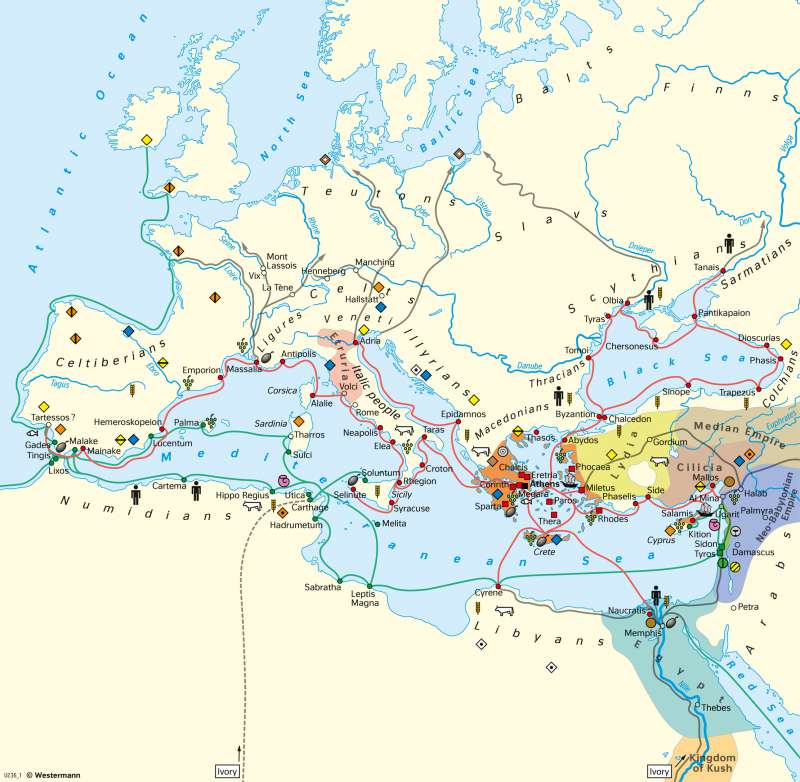Europe - Phoenician and Greek colonisation
Classical antiquity
978-3-14-100890-6 | Page 56 | Ill. 1

Overview
Between the 11th and 8th centuries BC, the Phoenicians (or Phoenicians) dominated large parts of the Mediterranean in economic and cultural terms. They never founded an empire, however, but lived in small, independent city-states on the east coast of the Mediterranean in what is now Lebanon and Syria. The collective name "Phoenicians" was only given to them by the Greeks. From about 800 BC onwards, they lost their supremacy, and the period of Greek antiquity began. While the Phoenician colonisation had been for economic reasons, the Greeks founded colonies to provide for the continuously increasing population of the mother cities.
The Phoenicians
The rise of the Phoenicians began after the end of the Sea Peoples' War. They laid out their cities with certain considerations in mind. It was important that they could be well defended, that fertile farmland was available in the immediate vicinity and that, if possible, a summer and winter harbour could be built. The towns were narrow, the houses modest, the trades distributed in different quarters and the population probably consisted of few thousand. It is assumed that the Phoenicians had a differentiated court system for handling civil cases.
Crucial to the rise of the Phoenician cities was that the great caravan routes ended at the Lebanese coast. A large part of the goods that reached the markets between the Euphrates and Tigris and throughout the Mediterranean in antiquity had begun their journey on Phoenician ships or had been stored in Phoenician storehouses.
But the Phoenicians were not only middlemen. An important export commodity was cedar and pine wood, which was used in Egypt to make furniture and ships. A second valuable commodity was purple dye, which was mainly extracted in Tyros and Sidon. Its raw material was a rock snail (Muricidae), common in coastal waters, from which the coveted colour was obtained by a process of putrefaction. The Tyrian royal purple, a deep violet, was known throughout the ancient world and in some countries it was only allowed to be worn by kings.
In addition, the Phoenicians displayed great craftsmanship. Through their extensive travels in the Mediterranean and the Atlantic, they continually discovered new raw materials, processing techniques and styles. They developed a great art in jewellery making from ivory and precious metals. Furthermore, they were masters in the production of metal vessels, silver bowls, copper and bronze bowls. Phoenician craftsmen travelled all the coasts of the Mediterranean on workshop boats. However, they did not develop a "Phoenician" style, but imitated models from Mesopotamia, Egypt or the Aegean.
In the 11th century BC, the Phoenicians began founding colonies and trading factories in Cyprus, Sicily, Malta, Sardinia and the Balearic Islands, in southern Spain and on the coast of North Africa. The starting points were cities such as Tyros, Sidon or Berytos (today: Beirut) further north. One of their most important colonies was Carthage, which was founded early on from Sidon, but only gained recognition as an ancient maritime power and important trading centre through the new city created from Tyros in 814. The Phoenicians also crossed the Strait of Gibraltar and founded the port city of Gades (today: Cádiz). Settlements followed on the West African and Portuguese coasts, and in the north, they advanced along Brittany to the British Isles and Ireland.
One of the most important cultural achievements of the Phoenicians was the further development of the alphabet. The inhabitants of Ugarit had previously taken a decisive step when they took about 30 characters from the Mesopotamian cuneiform script that resembled the original cuneiform script but were completely different in nature because they denoted single consonants. Following this example, the Phoenicians took the 25 phonetic characters from the Egyptian character set and formed the first real alphabet from them, even though it still lacked the vowels - they were added to it later by the Greeks.
The Greeks
ion contributed greatly to the formation of a sense of belonging among all Greeks. The term "Hellenes" - as opposed to "barbarians" – as a collective term for all Greek tribes appears for the first time in Hesiod around 700 BC.




